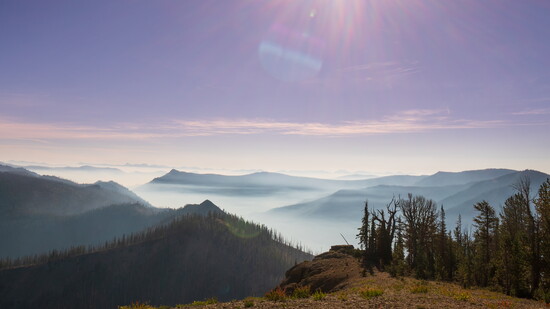Idaho is the only state surrounded by six states and one international boundary. Idaho's uniqueness spans border to border and watery depths to mountain peaks. Our landscapes and innovations are rich with firsts, deepest, biggest, and darkest places, as well as world-changing inventions. In part 1, learn about Idaho’s noteworthy landscapes and geography.
Landscapes
Idaho has waterfalls, canyons, rivers, sand, and mountains. These natural landscapes stand up to others nationwide for their biggest, tallest, and deepest accolades.
Shoshone Falls – Taller than Niagara Falls by 45 feet, Shoshone Falls is 212 feet high and nearly 1,000 feet wide. The Falls are along the Snake River (which starts in western Wyoming and flows westward into the Columbia River), not far from where Evel Knievel attempted to jump the Snake on a motorcycle in 1974. Since the 1860s and Idaho’s gold rush days, Shoshone Falls have been a tourist attraction. Nearby City of Twin Falls owns and manages the overlooking park.
From a tall water spot to a deep-water spot, let’s go to Hells Canyon. Also a part of the Snake River, Hells Canyon is the deepest river gorge in North America – 7,993 feet deep, which makes it deeper than the world-famous Grand Canyon in Arizona. Part of the Hells Canyon National Recreation Area, it includes more than 200,000 acres of wilderness for outdoor recreation enthusiasts.
Tall and deep, now let’s talk big! Bruneau Sand Dunes is North America’s tallest/biggest single-structure sand dune at 470 feet in height (more than twice as tall as Shoshone Falls) and about 576 acres of sand-dune. Operated by Idaho State Department of Parks and Recreation, this 4,800-acre park is a great day trip and camping location. Park activities also include: sandboarding, fishing, birding, swimming and hiking. The Bruneau Dunes Observatory (telescope) is great for stargazing.
Borah Peak, named after Senator Borah, is Idaho’s tallest mountain at over 12,660 feet. Found in the Challis National Forest, Mount Borah was officially recognized as Idaho’s only active glacier in 2021. A favorite of climbers who have courage, Borah Peak often bests even the most seasoned of climbers. One must start early to summit in time to return to the base before dark. Use great caution if attempting this climb and prepare yourself physically.
Now, for something dark. Dark Sky designations are given to places with little to no light pollution such that night skies are visible in great detail. Dark Sky parks are important for wildlife and insects. Idaho's largest is the Central Idaho Dark Sky Reserve which includes over 900,000 acres and was the 12th such recognized Reserve worldwide. Bring binoculars or a telescope to enhance your experience.
Geography.
Let’s flyover more incredible Idaho locations. First, the Frank Church (former Idaho Senator) River of No Return Wilderness is a protected 2.4 million acres of the largest contiguous federally managed wilderness (outside of Alaska). A wilderness designation means no motorized machinery can be used; however, Idaho was able to grandfather in jetboats and airstrips that existed before the designation.
Water! Idaho’s state Capitol Building in Boise is the only US Capitol heated by geothermal waters that flow under Boise heating some homes as well. Deep research: Lake Pend Oreille – submarine research in a Lake! At 1,152 feet deep, Lake Pend Oreille is the largest lake in Idaho and the 5th deepest lake in the nation. Pend Oreille makes for great research and recreation.
In Part 2: Celebrating Idaho’s Innovations all over the State. In part two, learn about things discovered and invented in Idaho!
